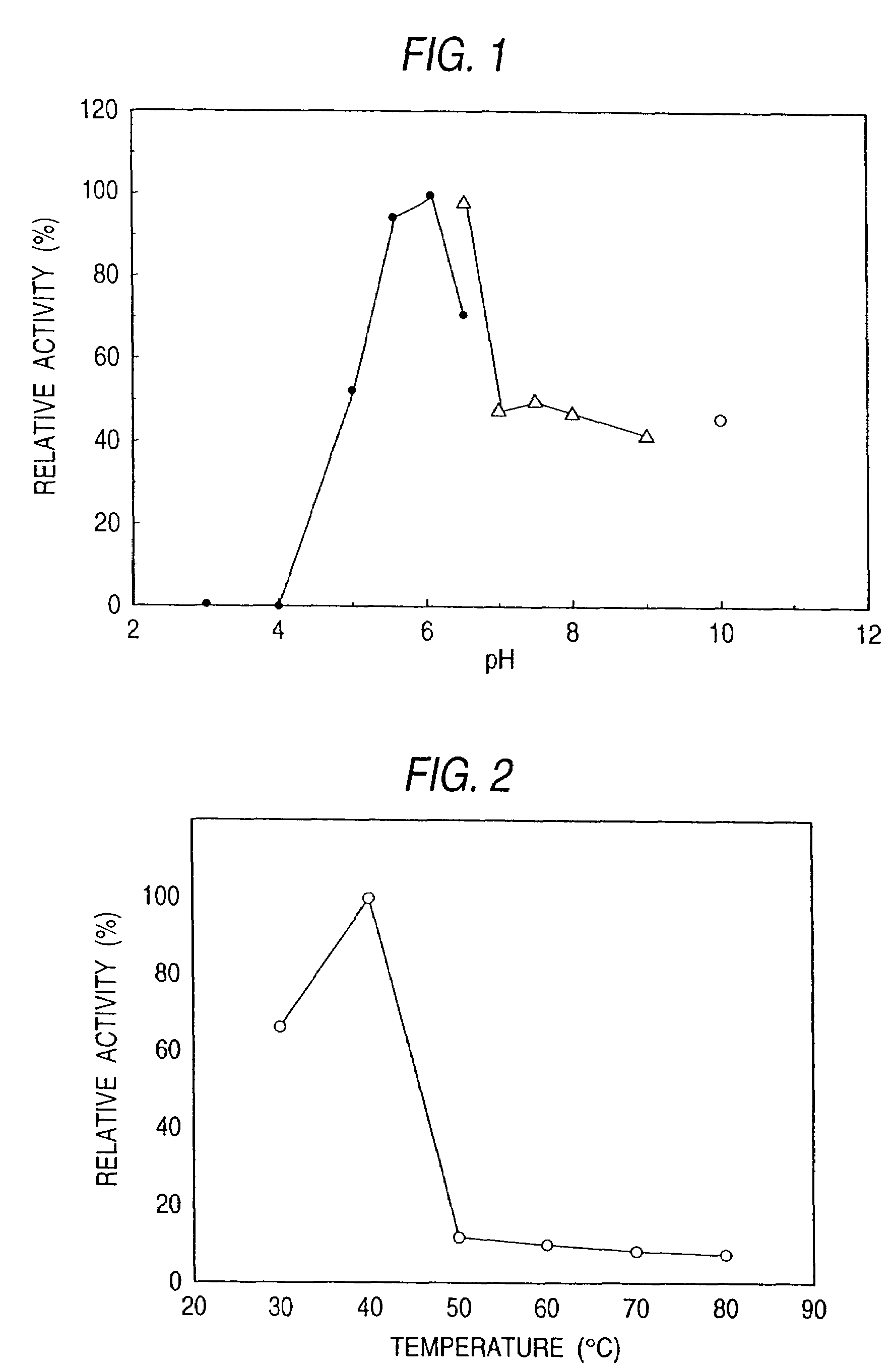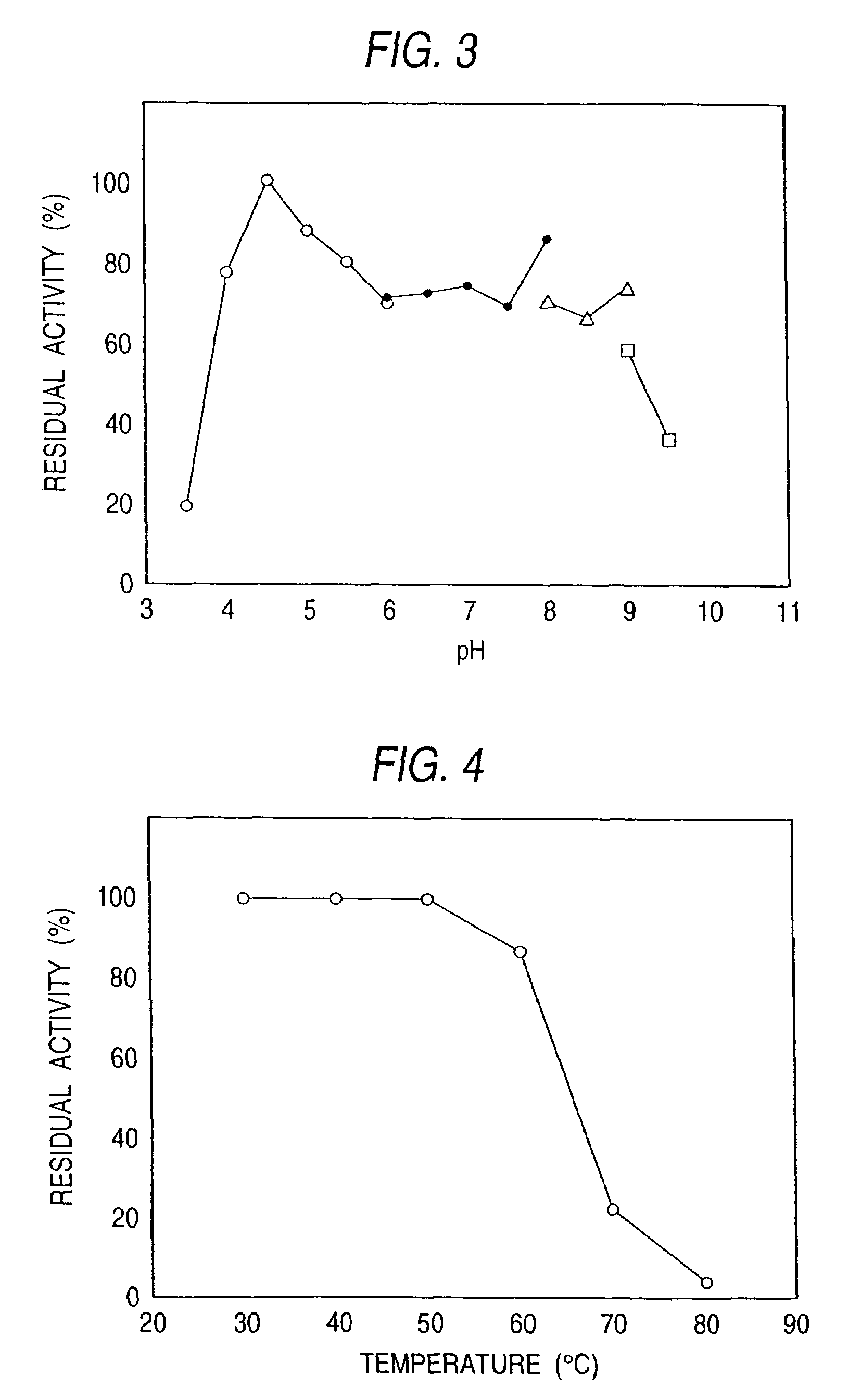Sphingolipid ceramide N-deacylase, methods for producing sphingolipids and sphingolipid derivatives, and sphingolipid ceramide N-deacylase gene
a technology of sphingolipid ceramide and ceramide, which is applied in the direction of organic chemistry, enzymology, group 5/15 element organic compounds, etc., can solve the problems of difficult to prepare a lyso-form of a polysialoganglioside having plural sialic acids, such as gq1b, according to the conventional chemical methods
- Summary
- Abstract
- Description
- Claims
- Application Information
AI Technical Summary
Benefits of technology
Problems solved by technology
Method used
Image
Examples
example 1
Isolation of SCDase
[0267]Pseudomonas sp. TK-4 (BP-5096) was inoculated to an inoculum size of 2% into a liquid medium, which contained 0.5% of peptone, 0.1% of yeast extract, 0.2% of NaCl and 0.1% of asialo GM1, and incubated therein at 30° C. for 48 hours. After the completion of the incubation, the culture medium was centrifuged at 6,000 rpm for 60 minutes. Thus the cells were eliminated and a culture supernatant was obtained. The subsequent procedures were all performed at 5° C. Ammonium sulfate was added to the culture supernatant to achieve 80% saturation. Then it was allowed to stand overnight and centrifuged at 6,000 rpm for 60 minutes. The precipitate thus obtained was collected and dissolved in a small amount of a 20 mM acetate buffer solution (pH 6.0) containing 0.2% of Lubrol. Next, it was dialyzed against the same buffer solution overnight. After the completion of the dialysis, the enzyme solution was subjected to gel filtration chromatography with the use of a Toyopearl...
example 2
Cloning of SCDase Structural Gene
(1) Extraction and Purification of Genomic DNA
[0268]An SCDase high production strain obtained by purifying an SCDase producing strain, Pseudomonas sp. TK-4 (FERM BP-5096), on a plate medium was named Pseudomonas sp. MF202, and Pseudomonas sp. MF202 was inoculated into 200 ml of LB medium (1% Bacto-trypton, 0.5% yeast extract, 0.5% NaCl) and cultured at 25° C. for 24 hours.
[0269]After completion of the culturing, the thus obtained culture broth was centrifuged to collect cells which were subsequently suspended in 10 ml of TE buffer (10 mM Tris-HCl, 1 mM EDTA, pH 8.0), and the resulting suspension was mixed with 0.2 ml of 50 mg / ml egg lysozyme and incubated at 30° C. for 15 minutes. This mixture was gently stirred by adding 2 ml of 10% SDS and then, when the solution became viscous, immediately mixed with 10 ml of saturated phenol in TE buffer and 1.5 ml of 5 M NaCl, and the mixture was gently stirred at room temperature for 1 hour. This mixture was ce...
example 3
Construction of Plasmid Capable of Expressing SCDase Polypeptide
(1) Construction of Plasmid Containing Full Length SCDase Gene
[0310]In order to construct a plasmid capable of expressing an SCDase polypeptide, pSK 33 was digested with a restriction enzyme PstI (manufactured by Takara Shuzo), the resulting DNA fragment containing a gene coding for a C-terminal side moiety of the SCDase was purified by 1% agarose gel electrophoresis and sub-cloned into the PstI site of pBluescript™ II SK (manufactured by Stratagene), and the thus obtained plasmid was named pSK P4.
[0311]The thus obtained pSK P4 was digested with a restriction enzyme ApaI (manufactured by Takara Shuzo) and a DNA fragment containing a gene coding for a C-terminal side moiety of the SCDase was extracted and purified. This DNA fragment was further digested with a restriction enzyme PstI (manufactured by Takara Shuzo), and a DNA fragment of about 260 bp containing a gene coding for a C-terminal side moiety of the SCDase was ...
PUM
| Property | Measurement | Unit |
|---|---|---|
| pH | aaaaa | aaaaa |
| wavelength | aaaaa | aaaaa |
| pH | aaaaa | aaaaa |
Abstract
Description
Claims
Application Information
 Login to View More
Login to View More - R&D
- Intellectual Property
- Life Sciences
- Materials
- Tech Scout
- Unparalleled Data Quality
- Higher Quality Content
- 60% Fewer Hallucinations
Browse by: Latest US Patents, China's latest patents, Technical Efficacy Thesaurus, Application Domain, Technology Topic, Popular Technical Reports.
© 2025 PatSnap. All rights reserved.Legal|Privacy policy|Modern Slavery Act Transparency Statement|Sitemap|About US| Contact US: help@patsnap.com



